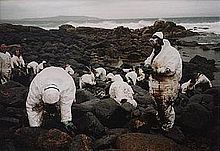- S-200 (fertilizer)
-
S-200 is a bioremediation product used to clean up oil spills. It is an oleophilic nitrogen-phosphorus fertilizer, sometimes known as a super nutrient, that promotes the growth of micro-organisms that degrade hydrocarbons (such as oil and fuel).S-200 is identified as a bioremediation accelerator and as such, does not contain bacterial cultures. The product contributes to the establishment of a robust microbial population. As per manufacturer instructions, additional nutrients are added to the product along with non-sterile site water and weathered oil. Considerable biodegradation to alkanes was seen over the course of treatment with 95.9% of these constituents reduced in 12 weeks. An 11.2% reduction in PAHs resulted from the S-200 treatment over 12 weeks, a reduction similar to that seen in Positive Control 2 flasks. The effects of S-200 were studied on a beach affected by the Prestige oil spill off the coast of Spain in 2002, the study concluded that S-200 enhanced the biodegradation rate of specific compounds, but the evidence did not establish whether it had improved the visible aspect of the beach, detached stuck oil, or reduced weathered oil. Other compounds, such as uric acid and lecithin, may be more effective than S-200.
In 2006, other researchers summarized the findings of experiments on Prestige-affected coastal areas, concluding that oloephilic fertilizers such as S-200 were of "limited effectiveness.[1]
The product was developed by International Environmental Products, a US company based around S-200 as its product.[2]
Contents
Field tests
In 2006, a field bioremediation assay was conducted by the Department of Microbiology, University of Barcelona on the use of S-200 ten months after the Prestige heavy fuel-oil spill on a beach of the Cantabrian coast in northern Spain. The field survey indicated that S-200 enhanced the biodegradation rate, particularly of high molecular weight n-alkanes, alkylcyclohexanes, and benzenes, and alkylated PAHs. The most significant molecular bioremediation indicators were the depletion of diasteranes and C-27 sterane components.[3]
However, the study was confined to analysis of specific compounds, and did not report whether the application of S-200 caused a decrease in the amount of weathered oil, the detachment of any oil that had been stuck, or any improvement to the visible appearance of the beach.[4]
In 2006, other researchers summarized the findings of experiments on Prestige-affected coastal areas, concluding that oloephilic fertilizers such as S-200 were of "limited effectiveness".[5]
A 2007 test by researchers at the Technical University of Crete comparing a control to treatment by S-200 and treatment by uric acid and lecithin found that the hydrocarbon degradation in a period of 7 days was greater with the uric acid and lecithin treatment than it was with the S-200 treatment and the control.[6]
References
- ^ J.R. Gallego, E. Gonzalez-Rojas, A. I. Pelaez, J. Sanchez, M. J. Garcia-Martinez, and J. F. Llamas. "Effectiveness of bioremediation for the Prestige fuel spill: A summary of case studies". Advanced Technology in the Environmental Field: Second IASTED International Conference Proceedings. February 6–8, 2006; Lanzarote, Spain.
- ^ IEP Develops cost-effective oil pollution treatment. . Industrial Environment (International Environmental Products). 2005-07-01. http://www.entrepreneur.com/tradejournals/article/133401958.html. Retrieved 2009-05-03.
- ^ Núria Jiménez, Marc Viñas, Jordi Sabaté, Sergi Díez, Josep M. Bayona, Anna M. Solanas, and Joan Albaiges (2006). "The Prestige Oil Spill. 2. Enhanced Biodegradation of a Heavy Fuel Oil under Field Conditions by the Use of an Oleophilic Fertilizer". Environmental Science & Technology (American Chemical Society) 40 (8): 2578–2585. doi:10.1021/es052370z. http://pubs.acs.org/doi/abs/10.1021/es052370z. Retrieved 2009-05-03.
- ^ P. Fernández-Álvarez, J. Vila, J.M. Garrido, M. Grifoll, G. Feijoo, and J.M. Lema (2007). "Evaluation of biodiesel as bioremediation agent for the treatment of the shore affected by the heavy oil spill of the Prestige" (PDF). Journal of Hazardous Materials 147: 920. http://www.usc.es/biogrup/2007%20J%20H%20M%20Biodiesel%20Paula%20Fdez.pdf.
- ^ J.R. Gallego, E. Gonzalez-Rojas, A. I. Pelaez, J. Sanchez, M. J. Garcia-Martinez, and J. F. Llamas. "Effectiveness of bioremediation for the Prestige fuel spill: A summary of case studies". Advanced Technology in the Environmental Field: Second IASTED International Conference Proceedings. February 6–8, 2006; Lanzarote, Spain.
- ^ M. Nikolopoulou, N. Pasadakis, N. Kalogerakis (2007-06-10). "Enhanced bioremediation of crude oil utilizing lipophilic fertilizers". Desalination 211 (1–3): 286–295. doi:10.1016/j.desal.2006.02.095.
- Ralph J. Portier, Ph.D. Professor of Environmental Sciences,Laura M. Basirico, MS. Research Associate 3 (2011) (PDF). Laboratory Screening of Commercial Bioremediation Agents for the Deepwater Horizon Spill Response. http://www.oilgoneeasy.com/biochemreport.pdf.
Further reading
- J.R. Gallego, J.R. Fernández, F. Díez-Sanz, S. Ordoñez, H. Sastre, E. González-Rojas, Ana I. Peláez, and J. Sánchez (May 2007). "Bioremediation for Shoreline Cleanup: In Situ vs. On-Site Treatments". Environmental Engineering Science 24 (4): 493. doi:10.1089/ees.2006.0091.
- J.R. Gallego, E. González-Rojas, A.I. Peláez, J. Sánchez, M.J. García-Martínez, J.E. Ortiz, T. Torres, and J.F. Llamas (December 2006). "Natural attenuation and bioremediation of Prestige fuel oil along the Atlantic coast of Galicia (Spain)". Organic Geochemistry 37 (12): 1869–1884. doi:10.1016/j.orggeochem.2006.07.022.
- Myriam Sanna, Magdalena Grifoll, and José Julio Ortega (2007). "Biodegradation of PAHs at solid/water and organic-liquid/water interfaces: Influence of an oleophilic fertilizer" (Microsoft Word). VERTIMAR-2007 Symposium on Marine Accidental Oil Spills, Vigo, Spain, June 5–8 2007. http://otvm.uvigo.es/vertimar2007/comunicaciones/VEM2004-08556_Sanna.doc.
- Núria JIMÉNEZ, Sergi DÍEZ, Jordi SABATÉ, Marc VIÑAS, Josep M. BAYONA, Joan ALBAIGÉS, and Anna M. SOLANAS (2005). "Enhanced biodegradation of fuel from the Prestige: in vitro and field assays" (Microsoft Word). VERTIMAR-2005 Symposium on Marine Accidental Oil Spills, Vigo, Spain, July 13–16 2005. http://otvm.uvigo.es/vertimar2005/comunicaciones/1090_VEM2003-20068-C05-04_solanas.doc. — also available as:
- Núria Jiménez, Sergi Díez, Jordi Sabaté, Marc Viñas, Josep M. Bayona, Joan Albaigés, and Anna M. Solanas (2005). "Enhanced biodegradation of the Prestige fuel oil: laboratory and field observations" (PDF). Theme Session S: Oil Spills in Marine Ecosystems: Impacts and Remediation. ICES CM 2005/S:15. http://www.ices.dk/products/CMdocs/2005/S/S1505.pdf.
- C. Calvo, G. A. Silva-Castro, I. Uad, C. García Fandiño, J. Laguna, and J. González-López (November 2008). "Efficiency of the EPS emulsifier produced by Ochrobactrum anthropi in different hydrocarbon bioremediation assays". Journal of Industrial Microbiology and Biotechnology (Springer) 35 (11): 1493–1501. doi:10.1007/s10295-008-0451-5. PMID 18784947. — a study that includes the combination of S-200 with the EPS emulsifier
External links
Categories:- Bioremediation
- Oil spill remediation technologies
Wikimedia Foundation. 2010.

